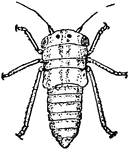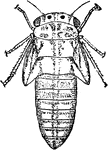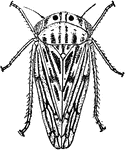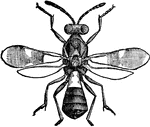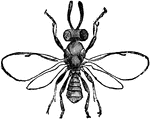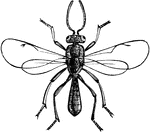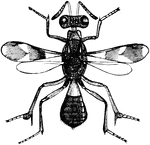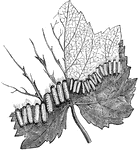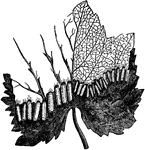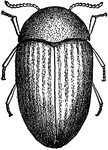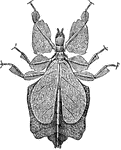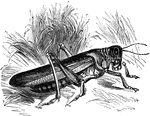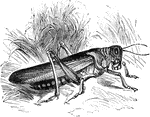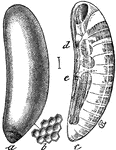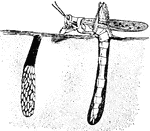This gallery includes 949 illustrations of other orders of insects.

Ichneumon Fly
Ichneumon flies have slender bodies, veined wings with the veins enclosing several spaces or cells,…

Ichneumon Fly
Ichneumon flies deposit their eggs upon the bodies of other insects and larva. The larva live on the…

Katydid
The Southern Katydid, Microcentrum laurifolium- 1, the female adult; 1a, eggs laid on leaves and twigs…
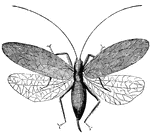
Katydid
Katydids are in the grasshopper family. The male makes noise by rubbing together two stiff, thin membranes…
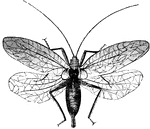
Katydid
Katydids are in the grasshopper family. The male makes noise by rubbing together two stiff, thin membranes…

Larva of a Ladybird
Ladybirds and their larva are beneficial to gardens because they eat other insects as food.
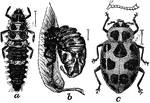
Spotted Ladybird
Also known as megilla maculata. A-Larva; B-Empty skin; C-Beetle with enlarged antenna above.
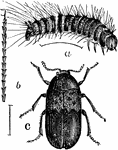
Larder Beetle Larvae and Imago
"Figure 10- Dermestes lardarius (Larder beetle) enlarged. a, larva; b, an enlarged hair; c, imago."…

Caterpillar and Chrysalis of Large Cabbage Butterly
The chrysalis of the large cabbage butterfly caterpillar is sometimes found directly on the cabbage…

Large White Cabbage Butterfly
A female large white cabbage butterfly has two large black spots on each upper wing. The body is black…

Larva of Goat Moth
Goat moth caterpillars are destructive to timber and fruit trees. When fully grown the caterpillar is…
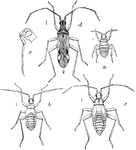
Leaf Bug
"The 'leaf bug' (Dicyphus minimus): a, newly hatched; b, second stage; c, nymph; d, adult; e, head and…

Leaf Bug and Plant Bug
Illustrated are nymphs of the four-lined leaf bug and the adult of the tarnished plant bug. The small…

Leaf Insect
Walking Sticks and Leaf Insects lead a sluggish life among the branches of shrubs, living on the young…

Leaf Insect
The leaf insect or walking leaf is an insect that has the appearance of a leaf from the family Phylliidae.

Leaf-Miners' Galleries in Elm
The larvae of leaf-miners eat out the tissue of the leaves of elm between the lateral veins. This leaves…
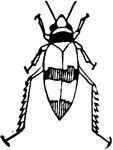
Threebanded Grape Leafhopper Imago
The imago stage of the Threebanded Grape Leafhopper (Erythroneura tricincta) is an insect in the Cicadellidae…
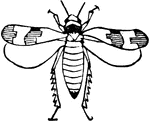
Threebanded Grape Leafhopper Imago
The imago stage of the Threebanded Grape Leafhopper (Erythroneura tricincta) is an insect in the Cicadellidae…

Threebanded Grape Leafhopper Pupa
The pupa of the Threebanded Grape Leafhopper (Erythroneura tricincta) is an insect in the Cicadellidae…
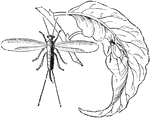
Lecanium Persicae
Pictured is a leaf with a male on it, slightly enlarge (a) and a male flying, much enlarged (b). Lecanium…
Larva of a Leopard Moth
Larva are unlike the mature insect. Larva of the moth or butterfly resemble worms. It may have a distinct…

Locust
Locusts are in the grasshopper family, although they have shorter legs and antennae. They can be extensively…
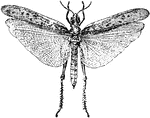
Locust
"The locusts come down in swarms of millions from the warm lands of southern Brazil. There are so many…

Locust
The name of several species of insects allied to grasshoppers and crickets. The term is applied conjointly…
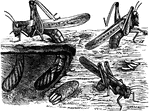
Locust
Rocky Mountain locust ovipositing. a,a, females with abdomen inserted in the soil; b, an egg-pod broken…

Locust
A group of related genera is call a family. Schistocerca melanocera Stol from Charles Island. Locust…

Locust
A group of related genera is call a family. S. intermedia borealis Snodgrass from Abingdon and Bindloe…

Locust
A group of related genera is call a family. S. intermedia Snodgrass from Duncan Islands. Locust taken…

Locust
A group of related genera is call a family. S. literosa Walker from Chatham Island. Locust taken on…
Locust
A group of related genera is call a family. S. melanocera lineata Snodgrass from Albemarle Island. Locust…
Locust
A group of related genera is call a family. S. melanocera immaculata Snodgrass from Indefatigable Island.…

Locust
Locust is the swarming phase of short-horned grasshoppers of the family Acrididae. These are species…

Locust (Acridium Edipoda Migratorium)
"They will inflate themselves with air, and undertake journeys during which they travel more than eighteen…

Locust Anatomy
Enlarged end of the female, showing oviposition: the oviduct, the egg guide, and the egg issuing from…

Seventeen Year Locust
The Seventeen Year Locust (Cicada septendecim) spends seventeen years underground feeding on the roots…
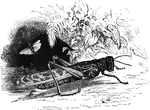
Locusta Cristata
"The migratory locust measures about two and a half inches in length, and some other exotic species…



